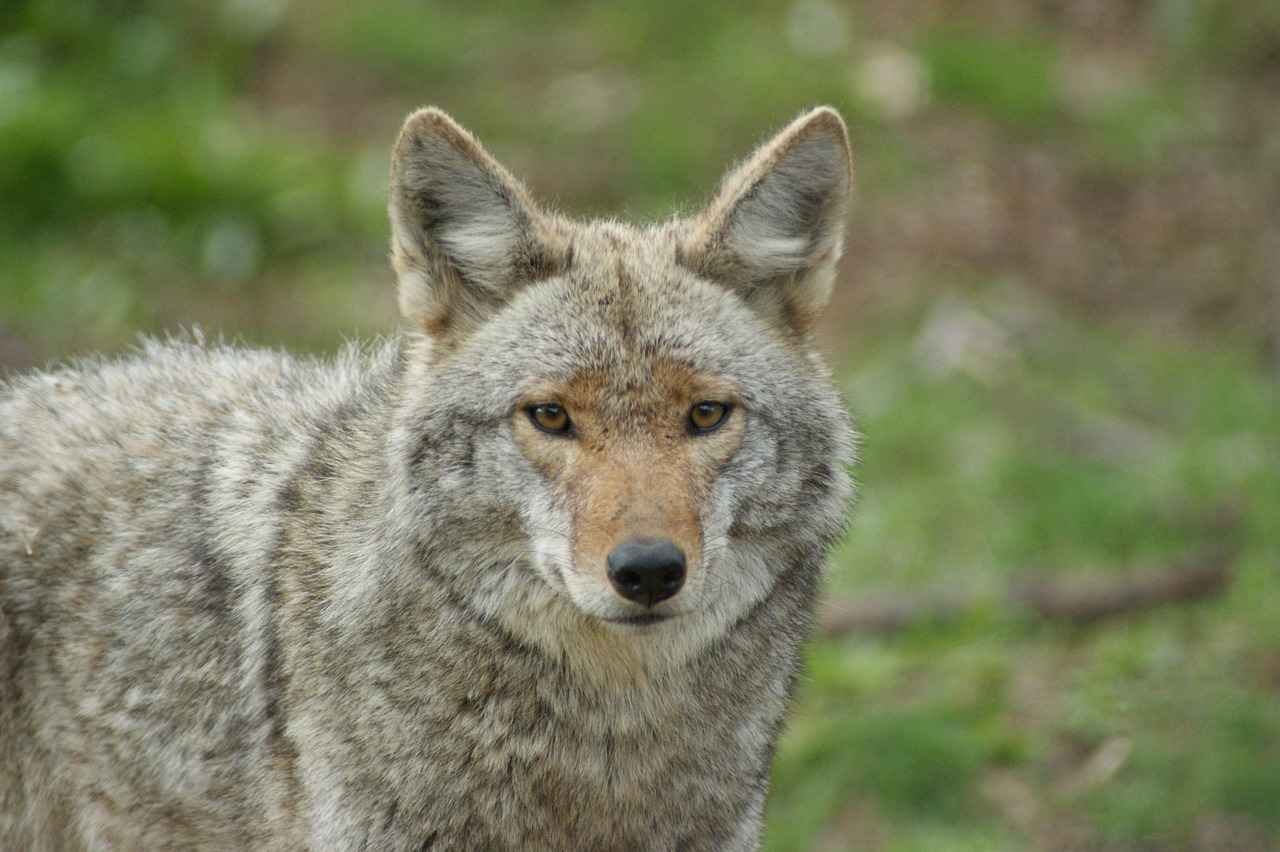This article explores practical and effective methods to deter coyotes from residential areas, ensuring safety for pets and families while maintaining a balanced ecosystem. As urban development expands, coyotes increasingly venture into neighborhoods, making it essential for homeowners to adopt strategies to keep them at bay.
Why Are Coyotes Entering Urban Areas?
Understanding the reasons behind coyote encroachment is crucial for effective deterrence. Urbanization, food availability, and habitat loss contribute to their presence in neighborhoods. With fewer natural habitats, coyotes adapt to urban environments, seeking food sources such as garbage, pet food, and small animals.
What Sounds and Noises Scare Coyotes Away?
Utilizing specific sounds can effectively deter coyotes. High-pitched noises, alarms, and recorded distress calls can create an unwelcoming environment for these animals. Sound-based deterrents can be a humane way to encourage coyotes to leave your property.
- Using Noise-Making Devices: Devices like air horns or ultrasonic repellents can disrupt coyote behavior.
- Choosing the Right Device: Select a device that suits your environment, considering factors like volume and portability.
- Timing and Frequency of Use: Use these devices at dusk and dawn when coyotes are most active for maximum effectiveness.
Natural Deterrents: What Works Best?
Natural deterrents can be an environmentally friendly way to keep coyotes at bay. Certain scents, such as those from predator urine or citrus, can discourage their presence without harming wildlife. Implementing these strategies can enhance your property’s defenses.
How to Use Fencing as a Coyote Deterrent?
Installing proper fencing is a proactive measure to prevent coyotes from entering your property. Understanding the types of fencing and their effectiveness is key to success.
- Types of Fencing for Coyote Prevention: Chain-link and stock fencing offer varying levels of protection.
- Height and Design Considerations: A fence should ideally be at least six feet tall and may include an outward angle at the top to deter climbing.
What Role Does Habitat Modification Play?
Altering the environment around your home can significantly reduce coyote encounters. Simple changes can make your property less appealing to these animals.
- Removing Food Sources: Secure trash bins, remove pet food, and clean up fallen fruit to deter coyotes.
- Landscaping Tips to Discourage Coyotes: Use native plants that do not attract prey animals to make your yard less inviting for coyotes.
How Effective Are Motion-Activated Devices?
Motion-activated devices can be a powerful tool in scaring away coyotes. Understanding their functionality and placement can enhance their effectiveness. These devices can startle coyotes and deter them from approaching your property.
- Types of Motion-Activated Devices: Options include sprinklers and lights that activate upon detecting movement.
- Best Practices for Installation: Ensure devices cover areas where coyotes are likely to enter your property for optimal results.
In conclusion, employing a combination of these methods can significantly reduce the likelihood of coyote encounters in residential areas. By understanding their behavior and taking proactive measures, homeowners can create a safe environment for their families and pets while respecting the natural ecosystem.

Why Are Coyotes Entering Urban Areas?
Coyotes have increasingly become a common sight in urban areas, raising concerns among residents about safety and wildlife management. Understanding the underlying factors that drive these animals into neighborhoods is essential for effective deterrence and coexistence. This article delves into the key reasons for coyote encroachment, including urbanization, food availability, and habitat loss.
The rapid pace of urban development has significantly altered natural landscapes. As cities expand, they encroach upon traditional coyote habitats, forcing these animals to adapt to new environments. Urban areas often provide a mix of open spaces, parks, and residential backyards that can serve as makeshift habitats. This phenomenon is not just about physical space; it’s also about the availability of resources that urban settings can offer.
Coyotes are opportunistic feeders, and urban areas can provide an abundance of food sources. Common culprits include:
- Garbage: Improperly secured trash bins can attract coyotes looking for an easy meal.
- Pet Food: Leaving pet food outside can lure coyotes into residential yards.
- Small Animals: Urban environments often host rodents and other small animals, providing a steady food supply for coyotes.
As these animals become accustomed to finding food in urban settings, their presence becomes more frequent, leading to increased encounters with humans and pets.
As natural habitats are destroyed for development, coyotes are displaced and forced to venture into urban areas. This loss of habitat not only reduces their natural prey but also increases competition among wildlife. In search of survival, coyotes adapt to urban life, exploiting the resources available in neighborhoods.
Human activities often inadvertently contribute to coyote encroachment. For instance, landscaping choices can either attract or deter wildlife. Using native plants that do not support small mammals can help reduce the presence of coyotes. Additionally, community practices such as feeding stray animals can create a food source for coyotes, further encouraging their presence.
To effectively deter coyotes, it is crucial to understand their behavior. Coyotes are highly adaptable and intelligent animals that can thrive in diverse environments. Their social structure and pack mentality also play a role in their urban presence. When one coyote discovers a food source, it can attract others, leading to larger groups in urban neighborhoods.
Educating the community about coyote behavior and the reasons behind their urban presence is vital. Awareness campaigns can help residents understand how to secure their trash, keep pets indoors during high-risk hours, and avoid leaving food sources accessible. By fostering a community that is informed and proactive, we can mitigate coyote encounters and promote a safer coexistence.
In summary, the reasons behind coyote encroachment into urban areas are multifaceted, involving urbanization, food availability, habitat loss, and human behavior. Addressing these factors through education, community engagement, and practical deterrence methods can help keep both residents and wildlife safe.

What Sounds and Noises Scare Coyotes Away?
Coyotes have increasingly become a common sight in urban areas, leading to concerns about safety for pets and families. One effective strategy for deterring these wild canines is through the use of specific sounds and noises. Understanding how certain auditory stimuli can influence coyote behavior is essential for creating a safer environment.
Utilizing specific sounds can effectively deter coyotes. High-pitched noises, alarms, and even recorded distress calls can create an unwelcoming environment for these animals. The natural instinct of coyotes is to avoid potential threats, and loud, disruptive noises can trigger this instinct.
High-pitched sounds are particularly effective in scaring coyotes away. These sounds mimic the distress calls of prey animals, signaling danger. Devices such as air horns or whistles can create sudden, sharp noises that catch the attention of coyotes, prompting them to flee. Research indicates that coyotes are more likely to avoid areas where they perceive threats, making high-pitched noises a practical deterrent.
Another effective method involves using recorded distress calls from small animals. These recordings can evoke a strong response from coyotes, as they instinctively recognize these sounds as signs of potential prey in trouble. By playing these recordings at strategic times, such as during dusk or dawn when coyotes are most active, homeowners can significantly reduce the likelihood of coyote encounters.
- Ultrasonic Repellents: These devices emit high-frequency sounds that are unpleasant for coyotes but inaudible to humans. They can be placed around the perimeter of your property for continuous deterrence.
- Motion-Activated Alarms: Installing alarms that trigger upon detecting movement can startle coyotes and encourage them to leave the area. These devices can be particularly effective in residential neighborhoods.
- Portable Noise Makers: For those who enjoy outdoor activities, portable noise makers can be carried along to deter coyotes while hiking or camping.
To maximize the effectiveness of sound deterrents, timing and frequency of use are crucial. Coyotes are crepuscular, meaning they are most active during dawn and dusk. Utilizing noise-making devices during these peak times can significantly enhance their efficacy. Additionally, regular use of these sounds can condition coyotes to associate the area with discomfort, further encouraging them to stay away.
While sound is a powerful deterrent, combining auditory methods with other strategies can yield even better results. For instance, using sound in conjunction with physical barriers, such as fencing, can create a comprehensive defense against coyotes. Furthermore, maintaining a clean yard by securing trash and removing pet food can eliminate attractants, making your property less appealing to these animals.
In conclusion, employing a variety of sounds and noises can be an effective strategy for deterring coyotes from residential areas. By understanding their behavioral responses to high-pitched noises, recorded distress calls, and other auditory stimuli, homeowners can take proactive measures to ensure the safety of their families and pets.
Using Noise-Making Devices
When it comes to keeping coyotes at bay, noise-making devices serve as an effective solution. These tools can disrupt the natural behavior of coyotes and encourage them to steer clear of residential areas. Understanding how to utilize these devices effectively can significantly reduce coyote encounters in your neighborhood.
Noise-making devices include a variety of tools designed to emit loud sounds that can startle or scare away coyotes. Common examples are air horns, ultrasonic repellents, and even hand-held alarms. These devices work by creating an unexpected auditory stimulus that interrupts the animal’s normal activities, prompting them to flee.
Coyotes are naturally wary of loud and unfamiliar sounds. When exposed to sudden noises, their instinct is to retreat to a safer distance. This response can be particularly effective in urban settings, where coyotes may feel more vulnerable. By using noise-making devices, homeowners can create a deterrent effect that discourages coyotes from approaching.
Not all noise-making devices are created equal. Here are some factors to consider when selecting the most suitable one for your needs:
- Volume: Ensure the device emits a sound loud enough to reach coyotes but not so loud that it disturbs your neighbors.
- Portability: A lightweight and easy-to-carry device allows for quick deployment in various situations.
- Ease of Use: Choose a device that can be activated quickly, especially during unexpected encounters.
For maximum effectiveness, it is crucial to use noise-making devices at strategic times. Coyotes are typically most active during dusk and dawn, so deploying your device during these hours can yield better results. Regular use of these devices can condition coyotes to associate the area with unpleasant experiences, further encouraging them to stay away.
While noise-making devices are effective on their own, combining them with other deterrent methods can enhance their overall impact. For instance, using these devices in conjunction with motion-activated lights or fencing can create a multi-layered defense strategy. This approach not only disrupts coyote behavior but also makes your property less appealing.
When using noise-making devices, it is essential to consider the safety of both humans and pets. Ensure that the noise does not cause undue stress to your animals or disturb your neighbors. Additionally, be mindful of the local wildlife; excessive noise can have unintended consequences on other species in the area.
In summary, noise-making devices are a practical and effective tool for deterring coyotes from residential areas. By understanding how these devices work, selecting the right one, and using them strategically, homeowners can create a safer environment for their families and pets. Incorporating these devices as part of a comprehensive coyote management strategy can lead to a harmonious coexistence with wildlife while minimizing potential conflicts.
Choosing the Right Device
When it comes to keeping coyotes at bay, selecting the right noise-making device is crucial. With various options available, understanding how to choose one that suits your specific environment can significantly enhance its effectiveness. Below are some key factors to consider:
- Volume: The sound level of the device is essential. A louder device is more likely to startle coyotes, making them think twice about entering your territory. However, be mindful of your surroundings, as excessively loud devices may disturb neighbors or local wildlife.
- Portability: If you need to move the device around your property or take it with you on outings, consider its weight and size. A portable device allows for flexibility in deployment, ensuring you can respond quickly to any coyote sightings.
- Ease of Use: The device should be user-friendly. Look for options that are simple to operate, especially in high-stress situations. A device that requires minimal setup can be a lifesaver when you need to act quickly.
- Type of Sound: Different sounds can have varying effects on coyotes. Devices that emit high-pitched noises or distress calls may be more effective than those producing low-frequency sounds. Test different options to see which works best in your area.
- Battery Life: For devices that rely on batteries, consider how long they last. A device with a longer battery life will require less frequent maintenance, allowing you to focus on more pressing concerns.
Additionally, think about the environment in which you live. If you reside in a densely populated area, a discreet device that minimizes noise pollution might be more appropriate. Conversely, in rural settings, a more robust device may be beneficial.
Furthermore, consider the frequency of use. Using noise-making devices regularly can condition coyotes to associate your property with unpleasant experiences, effectively deterring them over time. For optimal results, deploy these devices during times when coyotes are most active, such as dusk and dawn.
In conclusion, choosing the right noise-making device involves evaluating factors like volume, portability, ease of use, and the specific environmental context. By selecting a device that aligns with these criteria, you can enhance your efforts to keep coyotes at a safe distance from your home.
Timing and Frequency of Use
play a crucial role in the effectiveness of noise-making devices when it comes to deterring coyotes from residential areas. Understanding the behavioral patterns of these animals can significantly enhance the success of your efforts.
Coyotes are most active during dusk and dawn, periods referred to as crepuscular hours. During these times, they are on the hunt for food and are more likely to venture into urban areas. Therefore, employing noise-making devices such as air horns, ultrasonic repellents, and even simple household items like pots and pans can be particularly effective when used strategically. The sudden noise created can startle coyotes and encourage them to retreat to safer, more natural habitats.
Additionally, it is important to consider the frequency of noise-making. Regular use of these devices can condition coyotes to associate the area with an uncomfortable experience, leading them to avoid it altogether. For instance, if you consistently use noise-making devices during the critical hours of dusk and dawn, coyotes will begin to learn that your property is not a safe place to explore.
- Consistency is Key: Make it a habit to use noise-making devices at the same times each day. This consistency helps reinforce the negative association with your property.
- Vary the Sounds: To prevent coyotes from becoming accustomed to a single sound, consider using different devices or varying the intensity and duration of the noise.
- Combine with Other Deterrents: While noise-making devices are effective, pairing them with other methods such as motion-activated lights or natural deterrents can create a multi-layered defense strategy.
In addition to timing and frequency, the location of your noise-making devices is equally important. Position them near entry points where coyotes are likely to approach, such as fences or pathways. This strategic placement ensures that the sounds reach the coyotes effectively, maximizing their impact.
Moreover, it is essential to monitor the response of local wildlife after implementing these measures. If you notice a decrease in coyote activity, it indicates that your efforts are working. However, if coyotes continue to frequent your property, it may be necessary to reassess your approach and possibly increase the intensity or frequency of the noise-making.
In conclusion, employing noise-making devices at the right times and with the correct frequency can significantly enhance your ability to deter coyotes from your property. By understanding their behavior and strategically implementing these devices, you can create an environment that discourages their presence, ensuring the safety of your pets and family while maintaining a harmonious coexistence with local wildlife.
Natural Deterrents: What Works Best?
When it comes to keeping coyotes at bay, natural deterrents serve as an effective and environmentally friendly option. These methods leverage certain scents and substances that can discourage coyotes from approaching residential areas, all while ensuring the safety of local wildlife. This article explores the best natural deterrents and how they can be implemented effectively.
Utilizing natural deterrents is a proactive approach to managing coyote presence. Some of the most effective options include:
- Strong Scents: Coyotes have a keen sense of smell. Utilizing scents such as cayenne pepper, garlic powder, or even human hair can create an unwelcoming environment. Sprinkling these substances around your yard can help to deter coyotes.
- Predator Urine: The use of predator urine, such as that from foxes or mountain lions, can signal to coyotes that they are in a territory occupied by a more dominant predator. This can discourage them from venturing into your area.
- Essential Oils: Certain essential oils, like peppermint or citronella, can be effective when mixed with water and sprayed around your property. The strong scent can irritate their sensitive noses, making them less likely to return.
To maximize the effectiveness of these natural deterrents, consider the following strategies:
- Regular Application: Natural deterrents may wash away or dissipate over time. Regularly reapplying these substances, especially after rain, ensures that their effectiveness is maintained.
- Combination of Methods: Using a combination of different natural deterrents can create a more formidable barrier against coyotes. For instance, combining strong scents with motion-activated devices can enhance your deterrent strategy.
- Targeted Areas: Focus on areas where coyotes are likely to enter your property, such as gates, pathways, and near trash bins. This targeted approach can help to create a more effective deterrent zone.
One of the primary advantages of using natural deterrents is their safety for other wildlife and pets. Unlike chemical repellents, natural options do not pose a risk of poisoning or harming non-target species. However, it’s important to ensure that these substances do not disrupt the local ecosystem. For example, using non-toxic ingredients ensures that beneficial insects and animals are not adversely affected.
In addition to natural deterrents, consider these complementary strategies:
- Habitat Modification: Altering your landscape can make it less appealing to coyotes. This includes removing tall grasses, dense shrubs, and other potential hiding spots.
- Secure Trash and Food Sources: Ensure that garbage bins are tightly sealed and that pet food is not left outside. Eliminating food sources is a critical step in discouraging coyote visits.
- Community Efforts: Engaging with neighbors can amplify the effectiveness of natural deterrents. By working together, you can create a larger area that is less inviting to coyotes.
In conclusion, natural deterrents offer a sustainable and humane approach to keeping coyotes at bay. By understanding the scents and substances that repel these animals and implementing them effectively, homeowners can create a safer environment for their families and pets while respecting local wildlife.

How to Use Fencing as a Coyote Deterrent?
When it comes to protecting your home and pets from coyotes, installing proper fencing is one of the most effective proactive measures you can take. Understanding the various types of fencing and their effectiveness is crucial for ensuring your property remains secure. This section will delve into the importance of fencing as a coyote deterrent and explore the best options available.
Coyotes are increasingly encroaching on urban areas, drawn by food sources and shelter. By installing a well-designed fence, you can create a physical barrier that makes it more challenging for these animals to enter your property. A robust fence not only protects your pets but also helps in maintaining a sense of safety for your family.
There are several types of fencing that can effectively deter coyotes:
- Chain-Link Fencing: This type of fencing is durable and can be reinforced with additional materials to prevent climbing.
- Wooden Fencing: Solid wooden fences can provide a visual barrier, but they must be at least six feet tall to be effective.
- Stock Fencing: Often used for livestock, this type of fencing can be effective when combined with barbed wire or electric fencing.
Coyotes are known for their agility and ability to jump high. Therefore, it is recommended that your fence be at least six feet tall. Additionally, consider the following design elements:
- Outward Angles: Adding an outward angle at the top of the fence can significantly reduce the chances of coyotes climbing over.
- Buried Fencing: Burying the bottom of the fence about a foot underground can prevent coyotes from digging underneath.
While a sturdy fence is a great start, combining it with other deterrents can enhance its effectiveness:
- Motion-Activated Lights: Installing lights that activate when they detect movement can startle coyotes and discourage them from approaching.
- Noise-Making Devices: Adding devices that produce loud noises when triggered can further deter coyotes from entering your yard.
Regular maintenance is essential to ensure your fencing remains effective. Inspect your fence frequently for any signs of damage or wear. Look for:
- Loose panels or posts that may need tightening.
- Holes or gaps that could allow coyotes to enter.
- Overgrown vegetation that may provide cover for coyotes.
While proper fencing is a critical component of coyote deterrence, it should not be the only method employed. Consider integrating habitat modification techniques, such as:
- Removing food sources like pet food and unsecured trash.
- Landscaping with plants that do not attract prey animals.
By combining fencing with these strategies, you can create a comprehensive defense against coyotes.
Types of Fencing for Coyote Prevention
When it comes to protecting your property from coyotes, understanding the types of fencing available is essential. Each fencing type offers different levels of security, and choosing the right one can significantly reduce the likelihood of coyote encounters.
- Chain-Link Fencing: This is a popular choice due to its durability and visibility. While it can effectively keep larger animals out, coyotes may still be able to climb or dig under it if not properly secured.
- Stock Fencing: Often used in rural areas, stock fencing is designed to keep livestock contained. It consists of vertical and horizontal wires that can deter coyotes, especially when combined with barbed wire at the top.
- Wood Fencing: Solid wood fences provide excellent barriers against coyotes. However, they need to be tall enough—at least six feet—to prevent jumping. Adding a slanted top can further enhance its effectiveness.
- PVC Fencing: This is a low-maintenance option that can mimic the appearance of wood. While it may not be as strong as wood or chain-link, it can still serve as a deterrent if built correctly.
- Electric Fencing: For those seeking maximum protection, electric fencing can be highly effective. It delivers a mild shock that deters coyotes from attempting to breach the barrier.
Before selecting a fence, it’s crucial to assess your property. Consider the following:
- Property Size: Larger properties may require more extensive fencing solutions to ensure complete coverage.
- Terrain: Hilly or uneven ground may necessitate a different fencing approach to maintain effectiveness.
- Surrounding Environment: If your property is near wooded areas or fields, you may need a taller and more secure fence to deter coyotes.
When it comes to fencing for coyote prevention, height and design are critical factors. A fence should ideally be at least six feet tall. Additionally, consider implementing the following design elements:
- Outward Angles: Adding an outward angle at the top of the fence can prevent coyotes from climbing over.
- Buried Fencing: Extending the fence underground by 12-18 inches can deter digging.
- Visibility: Ensure that the fence does not provide hiding spots for coyotes, as they prefer to approach undetected.
Yes, combining fencing with other deterrent methods can enhance effectiveness. For instance, using noise-making devices or motion-activated lights near the fence can create an unwelcoming environment for coyotes. Additionally, maintaining a clean yard by removing food sources can complement your fencing efforts.
In summary, selecting the appropriate fencing type and design is vital for coyote prevention. By understanding the various options available and assessing your property’s specific needs, you can create a secure environment that minimizes the risk of coyote encounters.
Height and Design Considerations
Coyotes are known for their remarkable agility and jumping skills, making it essential to consider both the height and design of fences when trying to keep them out of residential areas. A fence should ideally be at least six feet tall to effectively deter these clever canines from entering your property. However, just having a tall fence is not enough; the design plays a crucial role in enhancing its effectiveness.
One effective design feature is to include an outward angle at the top of the fence. This design makes it more difficult for coyotes to climb over. The outward angle can be a simple extension of the fence material, sloping away from the property at about a 45-degree angle. This modification can significantly reduce the likelihood of a coyote successfully scaling the fence.
In addition to height and angle, the material used for the fence is also important. Chain-link fences are a popular choice due to their durability, but they may not be the most effective against determined coyotes. Instead, consider using solid wood or vinyl fencing, which can obstruct the coyote’s view and make the area feel less welcoming. Additionally, solid fences can prevent these animals from using the fence as a climbing aid.
Another aspect to consider is the depth of the fence. Coyotes are known to dig, so extending the fence underground by at least 12 inches can help prevent them from burrowing underneath. This added depth is particularly crucial in areas where coyotes are known to be active.
Furthermore, maintaining your fence is vital. Regular checks for gaps, loose boards, or any signs of wear can help ensure that your fence remains a strong barrier. If you notice any damage, promptly repair it to maintain the fence’s integrity.
Incorporating additional deterrents alongside your fence can further enhance its effectiveness. For example, placing motion-activated lights or sprinklers near the fence can startle coyotes and discourage them from approaching. These devices can create an unwelcoming environment, making it less likely for coyotes to venture close to your property.
Finally, consider the overall layout of your yard. Keeping shrubs and trees trimmed and away from the fence line can reduce hiding spots for coyotes, making your property less appealing. A well-maintained yard not only enhances the aesthetics of your home but also plays a crucial role in coyote deterrence.
In summary, the height and design of your fence are critical factors in keeping coyotes at bay. By ensuring your fence is at least six feet tall, incorporating an outward angle, using solid materials, and maintaining it well, you can create an effective barrier against these agile animals. Additionally, combining these strategies with other deterrents and proper yard maintenance will further enhance your efforts to protect your home and pets.

What Role Does Habitat Modification Play?
When it comes to managing coyote encounters, understanding the role of habitat modification is essential. By making strategic changes to the environment surrounding your home, you can significantly reduce the likelihood of these animals venturing into your space. Implementing a few simple modifications can make your property less appealing to coyotes and enhance safety for your family and pets.
Habitat modification is crucial as it directly affects the behavior and movement of coyotes. These animals are opportunistic feeders, drawn to areas that provide easy access to food, water, and shelter. By altering the landscape around your home, you can create an environment that is less attractive to them.
- Secure Trash Bins: Ensure that all garbage is stored in coyote-proof containers. Use bins with tight-fitting lids to prevent access.
- Remove Pet Food: Do not leave pet food outside, especially at night. This can attract coyotes looking for an easy meal.
- Clean Up Fallen Fruit: If you have fruit trees, regularly pick up any fallen fruit, as this can be a significant food source for coyotes.
Landscaping plays a vital role in discouraging coyotes from entering your property. Here are some effective tips:
- Use Native Plants: Planting native species that do not attract small mammals can help reduce the presence of prey animals, making your yard less appealing to coyotes.
- Avoid Dense Shrubs: Keep your landscaping open and avoid dense shrubbery where coyotes can hide and stalk their prey.
- Install Fencing: A sturdy fence can deter coyotes. Consider a fence that is at least six feet tall and extends underground to prevent digging.
Water sources can draw coyotes into residential areas. Here are some ways to manage water availability:
- Eliminate Standing Water: Remove any standing water in your yard, including bird baths and pet bowls, to make your property less inviting.
- Maintain Pools: If you have a swimming pool, ensure it is covered when not in use to prevent coyotes from using it as a water source.
In addition to food and water, consider the following factors:
- Lighting: Install motion-activated lights around your property to deter nocturnal animals, including coyotes, from entering your space.
- Noise: Utilize noise-making devices to create an unwelcoming environment. Sounds that startle coyotes can help keep them at bay.
Your pets can attract coyotes, so it’s essential to implement measures to protect them:
- Supervise Pets: Keep a close eye on pets when they are outside, especially during dawn and dusk when coyotes are most active.
- Leash Walks: Always walk pets on a leash, particularly in areas known for coyote activity.
By making these habitat modifications, you can significantly reduce the chances of coyote encounters in your neighborhood. Implementing these strategies not only protects your pets but also contributes to a safer community environment.
Removing Food Sources
Coyotes are known as opportunistic feeders, which means they will take advantage of any readily available food sources in urban environments. This behavior necessitates proactive measures from homeowners to minimize the likelihood of coyote encounters.
Understanding the significance of food sources in attracting coyotes is essential for effective deterrence. When food is easily accessible, coyotes are more likely to frequent residential areas, posing risks to pets and children. By removing these food sources, you create an environment that is less appealing to these animals.
One of the most common attractants for coyotes is unsecured trash. Here are some effective strategies:
- Use Animal-Proof Containers: Invest in trash bins that are specifically designed to be coyote-resistant. These bins often have locking mechanisms that prevent animals from accessing the contents.
- Secure Lids: Ensure that the lids of your trash cans are tightly closed. Consider using bungee cords or heavy weights to keep them secure.
- Regular Pickup: Schedule regular trash pickups to avoid leaving garbage out overnight, which can attract coyotes.
Another significant food source for coyotes is pet food. To mitigate this risk:
- Feed Pets Indoors: Always feed your pets inside, and avoid leaving food outside, especially at night.
- Store Pet Food Properly: Keep pet food in sealed containers to prevent odors from attracting coyotes.
- Clean Up After Pets: Promptly clean up any pet waste, as it can attract coyotes looking for an easy meal.
Landscaping can also play a crucial role in reducing coyote presence:
- Remove Fallen Fruit: If you have fruit trees, be diligent about picking up any fallen fruit. This can be a significant attractant for coyotes and other wildlife.
- Limit Bird Feeders: Bird feeders can attract smaller animals, which in turn can attract coyotes. If you use bird feeders, consider using squirrel-proof designs and clean up any spilled seeds.
- Use Non-Edible Plants: Opt for landscaping that features native plants that do not attract rodents or other prey animals, making your yard less appealing to coyotes.
Individual efforts are essential, but community involvement can amplify the effectiveness of these measures:
- Neighborhood Clean-Up Days: Organize events to clean up public spaces and educate neighbors about securing trash and food sources.
- Awareness Campaigns: Promote awareness about the importance of keeping food sources secure through flyers, community meetings, or social media.
- Collaboration with Local Authorities: Work with local wildlife agencies to develop strategies for reducing coyote attractants in your area.
By implementing these strategies, homeowners can significantly reduce the likelihood of attracting coyotes to their properties. Taking proactive steps to secure food sources not only enhances the safety of pets and families but also contributes to a healthier coexistence with wildlife.
Landscaping Tips to Discourage Coyotes
Landscaping plays a crucial role in creating a safe environment while also enhancing the beauty of your property. When it comes to discouraging coyotes, strategic landscaping can significantly reduce their presence in residential areas. By understanding the relationship between landscape design and wildlife behavior, homeowners can create a less inviting space for these animals.
Utilizing native plants is one of the most effective landscaping strategies for coyote deterrence. Native plants are adapted to the local environment and typically do not attract prey animals such as rabbits and rodents, which are food sources for coyotes. By eliminating these attractants, you can make your yard less appealing.
- Low Maintenance: Native plants require less water and fewer chemicals, making them easier to maintain.
- Enhanced Biodiversity: They support local wildlife, including beneficial insects and birds, without attracting coyotes.
- Natural Aesthetics: Native plants can create a beautiful and diverse landscape that blends seamlessly with the surrounding environment.
In addition to using native plants, consider the overall design of your landscape. Here are some effective strategies:
- Open Spaces: Maintain open areas in your yard to discourage coyotes from feeling secure. Dense shrubs or tall grass can provide cover, making it easier for them to approach unnoticed.
- Strategic Planting: Plant prickly or thorny bushes along the perimeter of your yard. These plants can act as a natural barrier, making it uncomfortable for coyotes to enter.
- Eliminate Hiding Spots: Regularly trim back overgrown areas and remove debris where coyotes might hide or nest.
While water features can enhance your landscape, they can also attract wildlife, including coyotes. If you have a pond or fountain, consider the following:
- Placement: Position water features away from areas where pets frequent.
- Size: Smaller water features are less likely to attract larger wildlife.
Once you’ve implemented these landscaping tips, ongoing maintenance is essential. Here are some practices to keep your yard coyote-resistant:
- Regular Clean-Up: Keep your yard free of food sources, such as fallen fruit or pet food left outside.
- Secure Trash Bins: Use animal-proof trash cans to prevent scavenging.
- Monitor Wildlife: Keep an eye on wildlife activity in your area. If you notice an increase in coyote sightings, it may be time to reevaluate your landscaping strategy.
By implementing these landscaping tips, you can create a less inviting environment for coyotes while enhancing the beauty and functionality of your yard. Remember, the goal is to maintain a balance between enjoying nature and ensuring the safety of your home and pets.

How Effective Are Motion-Activated Devices?
Motion-activated devices have emerged as a popular choice for homeowners looking to deter coyotes from their properties. These devices leverage technology to detect movement and respond in a way that can startle or scare off unwanted wildlife. Understanding how these devices work and where to place them can significantly enhance their effectiveness in keeping coyotes at bay.
What Types of Motion-Activated Devices Are Available?
- Motion-Activated Sprinklers: These devices release a sudden burst of water when they detect movement. The unexpected spray can startle coyotes, making them associate your yard with an unpleasant experience.
- Motion-Activated Lights: Bright lights can be an effective deterrent. When activated, they illuminate the area, which can disorient and scare off coyotes, especially during nighttime.
- Noise-Making Devices: Some devices emit loud noises or alarms when triggered. The sudden sound can create an immediate sense of danger for coyotes, prompting them to flee.
How to Choose the Right Motion-Activated Device?
Selecting the right device depends on various factors, including your property layout, the typical behavior of local coyotes, and your specific needs. Here are some considerations:
- Coverage Area: Ensure the device has a wide detection range to cover areas where coyotes are likely to enter.
- Power Source: Consider whether you prefer battery-operated devices for flexibility or wired devices for consistent power.
- Durability: Choose weather-resistant models to withstand outdoor conditions.
Best Practices for Installation
Proper installation and positioning of motion-activated devices are key to maximizing their impact. Here are some best practices:
- Placement: Install devices in areas where coyotes are frequently sighted, such as near fences, driveways, or gardens.
- Height and Angle: Adjust the height and angle of devices to ensure they can effectively detect movement at various levels.
- Combine Devices: Using a combination of different types of motion-activated devices can create a multi-sensory deterrent effect, making your property even less inviting to coyotes.
Timing and Frequency of Use
The effectiveness of motion-activated devices can also depend on the timing of their activation. Coyotes are most active during dusk and dawn, so setting devices to operate during these times can enhance their deterrent capabilities. Additionally, regular use can condition coyotes to avoid the area altogether.
Limitations of Motion-Activated Devices
While motion-activated devices can be highly effective, it’s essential to recognize their limitations. These devices may not be foolproof and can sometimes be triggered by non-threatening animals or environmental factors like wind. Therefore, it’s advisable to use them in conjunction with other deterrent methods, such as proper fencing and habitat modification, for the best results.
Conclusion
In summary, motion-activated devices can serve as a valuable tool in your strategy to deter coyotes from your property. By understanding their functionality, choosing the right types, and implementing best practices for installation, you can significantly enhance their effectiveness. Combining these devices with other deterrent measures will create a comprehensive approach to keeping your home and pets safe.
Types of Motion-Activated Devices
When it comes to keeping coyotes at bay, motion-activated devices serve as an effective deterrent. These devices not only startle coyotes but also create an environment that discourages their presence, ensuring the safety of your pets and family. Understanding the various types of motion-activated devices available can help you make an informed decision tailored to your property’s needs.
Motion-activated devices are tools designed to detect movement and respond with a stimulus, such as sound, light, or water. They are particularly useful in residential areas where coyotes may roam. By utilizing these devices, homeowners can create a deterrent zone that discourages coyotes from entering their property.
- Motion-Activated Sprinklers: These devices release a sudden burst of water when they detect movement. The unexpected spray can startle coyotes, making them associate the area with an unpleasant experience. They are particularly effective in gardens and yards.
- Motion-Activated Lights: Bright lights can be a powerful deterrent. When activated, they illuminate the area, startling coyotes and disrupting their natural behavior. This type of device is especially useful for driveways and entry points.
- Sound Devices: Devices that emit loud noises or alarms can effectively scare away coyotes. High-pitched sounds or recorded distress calls can create an unwelcoming atmosphere for these animals.
- Ultrasonic Repellents: These devices emit high-frequency sounds that are inaudible to humans but disturbing to coyotes. They can be particularly useful in residential settings where noise pollution is a concern.
Selecting the appropriate device depends on several factors:
- Property Layout: Consider the size and layout of your property. Larger areas may require multiple devices to cover all entry points effectively.
- Type of Coyote Activity: Understanding where coyotes are likely to enter your property can help you position devices strategically.
- Environmental Conditions: Factor in weather conditions and potential obstructions that may affect the device’s performance.
To maximize the effectiveness of motion-activated devices, proper installation is key:
- Placement: Position devices in areas where coyotes are known to frequent, such as near garbage bins or pet areas.
- Height and Angle: Ensure that sprinklers are angled to cover a wide area, and lights are mounted at a height that maximizes visibility.
- Regular Maintenance: Check devices regularly to ensure they are functioning correctly and adjust settings as necessary.
Using a combination of motion-activated devices can enhance their effectiveness. For example, pairing motion-activated lights with sound devices can create a multi-sensory deterrent that is more likely to scare coyotes away. Additionally, integrating natural deterrents, such as removing food sources and modifying landscaping, can further reduce the likelihood of coyote encounters.
By understanding the various types of motion-activated devices and implementing best practices for their use, homeowners can create a safer environment while respecting the natural ecosystem. These measures not only protect pets and families but also promote coexistence with wildlife.
Best Practices for Installation
When it comes to protecting your property from coyotes, proper installation and positioning of motion-activated devices can significantly enhance their effectiveness. These devices serve as a first line of defense, deterring coyotes and other wildlife from entering your space. To maximize their impact, it’s essential to follow some best practices for installation.
Understanding the significance of installation is crucial. A well-placed device can cover critical entry points where coyotes are likely to approach, while poor placement can render it ineffective. Here are some key considerations:
- Coverage Area: Ensure that the device is positioned to monitor the most vulnerable areas of your property, such as gates, driveways, and areas with dense vegetation.
- Height and Angle: Mount devices at an appropriate height, typically around 3 to 4 feet off the ground, and angle them slightly downward to capture motion effectively.
- Clear Line of Sight: Avoid obstructions like bushes or fences that could block the sensor’s detection range. A clear line of sight allows the device to function optimally.
Placement is key to ensuring that motion-activated devices are effective in scaring away coyotes. Here are some tips on choosing the right location:
- Entry Points: Focus on areas where coyotes are likely to enter your property. This includes gaps in fencing, along paths, or near food sources.
- Near Water Sources: Coyotes may be attracted to areas with water sources. Position devices near ponds, pools, or water features to deter them.
- Close to Habitats: If your property is near natural habitats like woods or fields, place devices at the perimeter to create a barrier against approaching coyotes.
Using multiple motion-activated devices can create a more robust defense system. Consider the following:
- Diverse Types: Incorporate different types of devices, such as lights, sprinklers, and sound alarms, to create a multi-sensory deterrent effect.
- Strategic Spacing: Space devices evenly around your property to cover more ground and create a comprehensive protective barrier.
- Regular Testing: Periodically test the devices to ensure they are functioning correctly and adjust their positions if necessary for optimal performance.
Regular maintenance is essential to ensure that your motion-activated devices remain effective over time. Here are some maintenance tips:
- Check Batteries: Regularly check and replace batteries to ensure devices remain operational.
- Clean Sensors: Dust and debris can obstruct sensors, so keep them clean to maintain their effectiveness.
- Inspect for Damage: Periodically inspect devices for any signs of wear or damage and replace them as needed.
By following these best practices for installation and maintenance, you can significantly enhance the effectiveness of motion-activated devices in deterring coyotes from your property. Remember that a proactive approach is vital in keeping your home and pets safe while contributing to a balanced ecosystem.
Frequently Asked Questions
- Why are coyotes coming into urban areas?
Coyotes are increasingly entering urban areas due to factors like urbanization, availability of food, and loss of natural habitat. As cities expand, these clever animals adapt to their surroundings, searching for easy meals and shelter.
- What sounds can scare coyotes away?
High-pitched noises, alarms, and recorded distress calls can effectively deter coyotes. These sounds create an unwelcoming environment that encourages them to leave the area.
- How can I use fencing to keep coyotes out?
Installing a fence is a proactive way to prevent coyotes from entering your property. A fence should ideally be at least six feet tall and may include an outward angle at the top to deter climbing. Different types of fencing offer varying levels of protection.
- What natural deterrents work best against coyotes?
Natural deterrents like certain scents and substances can discourage coyotes without harming wildlife. Keeping your yard clean and removing food sources, such as pet food and fallen fruit, is crucial for keeping these animals at bay.
- How effective are motion-activated devices?
Motion-activated devices, such as sprinklers and lights, can startle coyotes and are quite effective when properly placed. Ensure these devices cover areas where coyotes are likely to enter your property for the best results.




